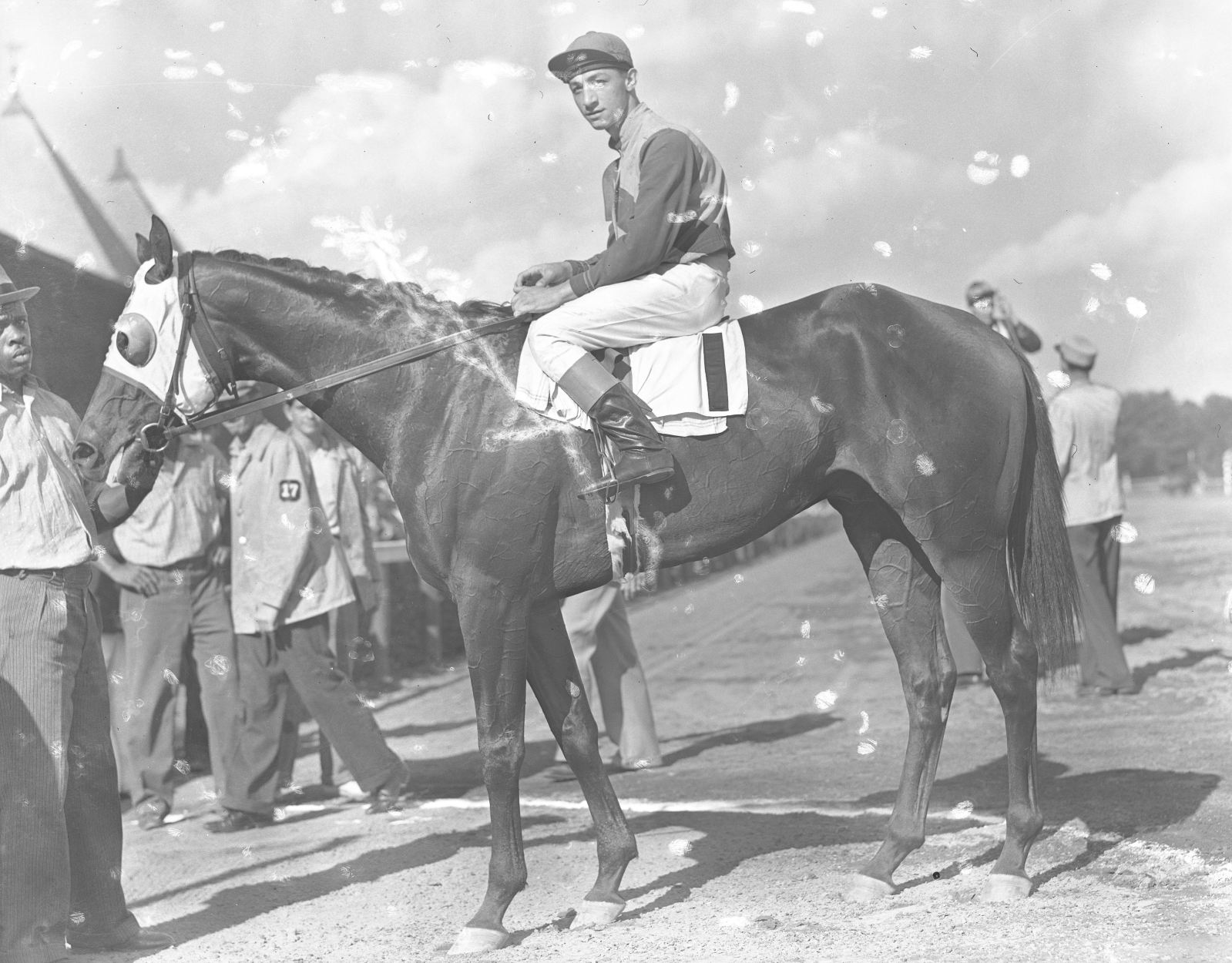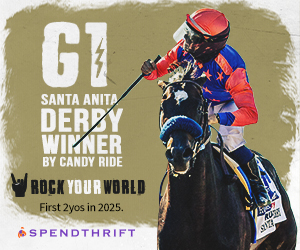
Keeneland Library Morgan Collection
My job requires spending time in the past, always looking back to what and who has come before and then finding those stories that beg for exploration. A good horse racing historian looks for a story wherever they go, with an eye toward a name or a moment that carries meaning for our time, putting the horses and the people we see now in perspective. As the calendar rolls toward its inevitable turn to a new year, these final months bring connections to traditions back to the fore as we celebrate the old year with family and friends, another coming together at times like Thanksgiving. I found it appropriate, therefore, that we celebrate this year’s feast with the story of a horse named Thanksgiving.
A smallish bay colt, absent of white from all appearances, Thanksgiving’s pedigree might have read as plain as his brown coat. His sire Bud Lerner was bred by John E. Madden and owned by Harry Sinclair’s Rancocas Stable; in 1923, his Rancocas stablemate Zev won the Kentucky Derby and Belmont Stakes, while Bud Lerner was unable to capitalize on his promising two-year-old season, injuries keeping him out of action for much of the year. Bud Lerner later became a decent sire, with 125 winners from his 185 foals, first as part of Rancocas’s breeding stock and then later as part of William Elder’s Merryland Farm.
Thanksgiving’s dam, Inchcape Belle, was also a product of Rancocas Stable, her sire Inchcape purchased by Sinclair for $150,000 in 1920. When injury ended his career as a three-year-old, Inchcape joined Purchase and Mad Hatter on Rancocas’s stallion roster, immediately servicing several broodmares. His first foals were promising, but a barn fire in April 1923 killed much of the farm’s breeding stock, including Inchcape and several of his foals. Inchcape Belle emerged as her sire’s only surviving foal, joining Merryland’s breeding stock when breeder William Elder purchased a number of Rancocas horses at Sinclair’s dispersal sale. Thanksgiving was her first foal by Bud Lerner; she would have three more foals by him, including the aptly named Turkey Wings, though none would have the same kind of career that Thanksgiving had.
His sire’s and dam’s names give no clues as to how Thanksgiving arrived at his singular name. Elder sold him as a yearling to Anna Corning, wife of Congressman Parker Corning from New York. The Cornings raced their horses in Anna’s name, with future Hall of Famer Max Hirsch as trainer. Thanksgiving joined Hirsch’s barn on the heels of two historic events for the family of horsemen: daughter Mary’s pioneering licensure as a trainer in 1934 and Hirsch’s Kentucky Derby-Preakness double with Bold Venture in 1936. By 1936, Mary had her first Derby starter, No Sir, and was quickly gaining a reputation as a trainer just as capable as her famed father. Thanksgiving joined their stable in 1937 at age two, breaking his maiden in just his second start. He won the Tuxedo Purse at Empire City a month later before the stable moved on to Saratoga for their August meet.
On July 27th, Max Hirsch was eating lunch in his kitchen near his backside barn when he felt something strike his foot. When he looked up, he saw that the chef was lying on the floor, knocked out by a bolt of lightning that had struck the barn area. Hirsch rushed over to see that the bolt had killed a filly, skipped a couple of stalls, and then hit Thanksgiving, who was out cold for several hours afterward. The colt made a full recovery, going on to compete in the Hopeful Stakes a month later, but did not win again in 1937.
Thanksgiving carried over the good impression he had made at two into his three-year-old season, Anna Corning nominating her good colt for a number of races that year, including the Kentucky Derby and the Preakness. Mrs. Corning also decided to change Thanksgiving’s trainer as the new year began: she tapped Mary Hirsch to prepare her good colt for his 1938 campaign. The colt started off his three-year-old campaign with a second and then a well-beaten sixth in the Chesapeake Stakes, knocking him out of Triple Crown contention. Thanksgiving returned to face champion two-year-old Menow in the Withers, finishing second, before winning the Constitution Handicap a week later.
Racing shifted to Saratoga in late July, the three-year-old division wide open after the Triple Crown races all had different winners. With the division absent of a leader, Thanksgiving still had his chance to make an impact – if he could win a race. After winning the Constitution, the colt turned in four more performances where he broke track records, yet in each he finished just behind the winners, barely missing out on records right and left. On July 29th, Thanksgiving won the Saranac Handicap and then entered the Travers Stakes two weeks later primed for a singular performance.

The Travers field was deep: Fighting Fox, Stagehand, Cravat, and Bull Lea among the nine entrants. Fighting Fox, a full brother to 1930 Triple Crown winner Gallant Fox, had won the Wood Memorial, but did best in sprints rather than distance races. Stagehand had won the Santa Anita Derby and beaten Thanksgiving by a half-length in the Empire City Handicap in June. Cravat had finished second in the Preakness and third in the Belmont and had beaten Thanksgiving in the Yankee Handicap earlier in the summer. Bull Lea, perhaps the most recognizable name among the lot, had set a track record in the Bluegrass Stakes before turning in lackluster performances in the Triple Crown races; later, of course, he would go on to become the foundation sire for Calumet Farm, but, in August 1938, he was another three-year-old trying to grab some claim to the division’s championship. Thanksgiving, though, blew by them all.
Ridden by the legendary Eddie Arcaro, Thanksgiving took the lead from the race’s start, holding the field at bay by several lengths at each pole. He drew away to a four-length win, never facing a challenge from the horses that trailed behind him. The foes that had beaten him in the summer’s close finishes, those that needed track records to beat him, couldn’t touch him that day. The smallish bay colt owned by a woman and trained by a pioneer, the son of one survivor who had survived a lightning strike himself, beat some of the best that his crop had to offer and etched his singular name in the roster of greats that had won the Travers Stakes. How much thanksgiving must have come from the Hirsches and Cornings on that historic day?
Thanksgiving won the Huron Handicap two weeks after the Travers, his final win of 1938. Despite Thanksgiving’s performances that year, Stagehand came away with the three-year-old championship on the strength of victories like his win over Seabiscuit in the Santa Anita Handicap. Thanksgiving returned to the races for his four-year-old season in 1939, winning only two of his fourteen starts. Mrs. Corning retired her Travers winner to stud in 1940, where he remained until 1943. Mrs. Corning died early that year, her husband Parker following in May.
Thanksgiving was part of the Corning consignment that sold at Belmont Park that same month. Philip Godfrey purchased Thanksgiving for $1,700; the stallion would go on to sire several horses for Godfrey in the 1940s. By the late 1950s, Thanksgiving had made his way to the aptly named Holiday Farm in Michigan, siring foals as late as 1958. So, as you sit down on Thursday to another year of family and feasting, as you observe the traditions that make the Thanksgiving holiday one of the highlights of each passing year, raise a glass to Thanksgiving, the Maryland-bred colt with strong women behind him and an even stronger record of surviving and thriving through challenges to compete with some of the best horses of his era.



